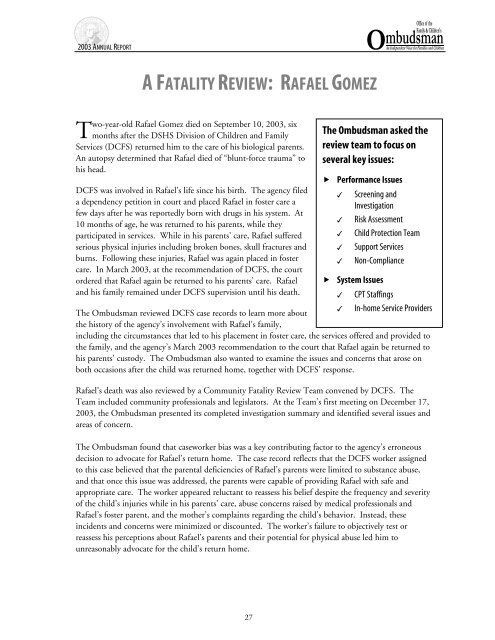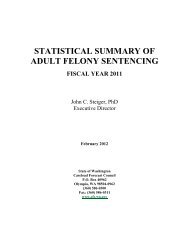a fatality review: rafael gomez - Washington State Digital Archives
a fatality review: rafael gomez - Washington State Digital Archives
a fatality review: rafael gomez - Washington State Digital Archives
You also want an ePaper? Increase the reach of your titles
YUMPU automatically turns print PDFs into web optimized ePapers that Google loves.
2003 ANNUAL REPORT<br />
T<br />
A FATALITY REVIEW: RAFAEL GOMEZ<br />
wo-year-old Rafael Gomez died on September 10, 2003, six<br />
months after the DSHS Division of Children and Family<br />
Services (DCFS) returned him to the care of his biological parents.<br />
An autopsy determined that Rafael died of “blunt-force trauma” to<br />
his head.<br />
DCFS was involved in Rafael’s life since his birth. The agency filed<br />
a dependency petition in court and placed Rafael in foster care a<br />
few days after he was reportedly born with drugs in his system. At<br />
10 months of age, he was returned to his parents, while they<br />
participated in services. While in his parents’ care, Rafael suffered<br />
serious physical injuries including broken bones, skull fractures and<br />
burns. Following these injuries, Rafael was again placed in foster<br />
care. In March 2003, at the recommendation of DCFS, the court<br />
ordered that Rafael again be returned to his parents’ care. Rafael<br />
and his family remained under DCFS supervision until his death.<br />
The Ombudsman asked the<br />
<strong>review</strong> team to focus on<br />
several key issues:<br />
Performance Issues<br />
Screening and<br />
Investigation<br />
Risk Assessment<br />
Child Protection Team<br />
Support Services<br />
Non-Compliance<br />
System Issues<br />
CPT Staffings<br />
The Ombudsman <strong>review</strong>ed DCFS case records to learn more about<br />
the history of the agency’s involvement with Rafael’s family,<br />
In-home Service Providers<br />
including the circumstances that led to his placement in foster care, the services offered and provided to<br />
the family, and the agency’s March 2003 recommendation to the court that Rafael again be returned to<br />
his parents’ custody. The Ombudsman also wanted to examine the issues and concerns that arose on<br />
both occasions after the child was returned home, together with DCFS’ response.<br />
Rafael’s death was also <strong>review</strong>ed by a Community Fatality Review Team convened by DCFS. The<br />
Team included community professionals and legislators. At the Team’s first meeting on December 17,<br />
2003, the Ombudsman presented its completed investigation summary and identified several issues and<br />
areas of concern.<br />
The Ombudsman found that caseworker bias was a key contributing factor to the agency’s erroneous<br />
decision to advocate for Rafael’s return home. The case record reflects that the DCFS worker assigned<br />
to this case believed that the parental deficiencies of Rafael’s parents were limited to substance abuse,<br />
and that once this issue was addressed, the parents were capable of providing Rafael with safe and<br />
appropriate care. The worker appeared reluctant to reassess his belief despite the frequency and severity<br />
of the child’s injuries while in his parents’ care, abuse concerns raised by medical professionals and<br />
Rafael’s foster parent, and the mother’s complaints regarding the child’s behavior. Instead, these<br />
incidents and concerns were minimized or discounted. The worker’s failure to objectively test or<br />
reassess his perceptions about Rafael’s parents and their potential for physical abuse led him to<br />
unreasonably advocate for the child’s return home.<br />
27
OFFICE OF THE FAMILY AND CHILDREN’S OMBUDSMAN<br />
Caseworker bias was also a prominent factor in the death of three-year-old Zy’Nyia Nobles in 2000.<br />
Zy’Nyia was killed by her mother several months after DCFS returned her to her mother’s care. In<br />
that case, the CWS worker appeared to act as the mother’s advocate and pushed for Zy’Nyia’s return<br />
home despite the mother’s violent history, documented concerns about her mental health and<br />
parenting capacity, and her failure to complete or make progress in court-ordered services. 1<br />
Despite previous efforts by the DSHS Children’s Administration to address this issue, biased decisionmaking<br />
by caseworkers persists and continues to place children at risk of serious harm.<br />
Considering the Issues<br />
The Ombudsman asked the Community Fatality Team to consider the following issues in a <strong>review</strong> of<br />
Rafael’s death.<br />
Performance Issues<br />
• Screening and Investigation—Shortly after Rafael was returned the first time to his parents’ care,<br />
DCFS Child Protective Services (CPS) received several reports clearly indicating that he was at<br />
risk of physical abuse. In fact, the child suffered several severe injuries while living with his<br />
parents. Case records indicate that many of these reports either were not investigated or<br />
determined to be inconclusive or invalid by CPS workers. Moreover, on one occasion, a DCFS<br />
Child Welfare Services (CWS) worker documented a service provider’s concern about the<br />
suspicious nature of one of Rafael’s injuries, but did not forward the concern to CPS for screening<br />
and investigation.<br />
• Risk Assessment—The severity and chronicity of Rafael’s injuries alone suggested the strong<br />
possibility of physical abuse. However, the CWS worker did not assess his parents’ risk for<br />
physical abuse – even though assessment tools specifically designed to identify this risk were<br />
available. The worker did obtain a “psycho-social” evaluation of both parents. However, this<br />
assessment was inadequate as assessment tools designed to measure the risk for physical abuse were<br />
not. Moreover, the worker failed to provide sufficient background information on the parents to<br />
the psycho-social evaluator.<br />
• Child Protection Team—The DCFS worker failed to provide complete information to the Child<br />
Protection Team (CPT) as it was deciding whether to support the worker’s plan to return Rafael<br />
home. 2<br />
Specifically, the Ombudsman questioned whether the CPT was provided with all<br />
medical reports and findings regarding the child’s injuries, as well as reports of maltreatment after<br />
the child was returned home. Additionally, the Ombudsman raised concerns that information to<br />
the CPT accentuated the parents’ progress and minimized any deficiencies. 3<br />
1<br />
Ombudsman July 2000 Review of Zy’Nyia Nobles Fatality (edited to protect confidentiality): www.governor.wa.gov/ofco.<br />
2<br />
RCW 74.14B.030 requires that DSHS “establish and maintain one or more multidisciplinary teams in each state region of<br />
the division of children and family services. The team shall consist of at least four persons, selected by the department, from<br />
professions which provide services to abused and neglected children and/or the parents of such children. The teams shall be<br />
available for consultation on all cases where a risk exists of serious harm to the child and where there is dispute over whether<br />
out-of-home placement is appropriate.”<br />
3<br />
Issues and recommendations regarding the use of Child Protection Teams are discussed in greater detail in the section titled<br />
“Exploring the Purpose and Value of Child Protection Teams” of this report.<br />
28
A FATALITY REVIEW: RAFAEL GOMEZ, 2003 ANNUAL REPORT<br />
• Support Services—The CWS worker did not ensure that critical in-home support services, such as<br />
of a public health nurse, were provided to Rafael’s family upon his return home. Also, the worker<br />
did not ensure that Rafael was provided with therapeutic day-care services to help address his<br />
reported behavioral problems and further assess his treatment needs.<br />
• Non-Compliance—Case records showed that Rafael’s mother did not fully comply with substance<br />
abuse treatment services. Moreover, on more than one occasion she insisted on changing<br />
treatment providers whom she perceived as being critical of her progress. There is no evidence<br />
that this caused the DCFS worker to reassess his support for returning Rafael to parent’s care.<br />
System Issues<br />
• CPT Staffings —The Ombudsman asked the Review Team to consider how the structure and<br />
operation of CPTs could be improved to enable them more effectively to fulfill their role.<br />
Specifically, the Ombudsman identified CPT membership, the decision making process, and the<br />
timing of CPT meetings as issues of concern.<br />
• In-home Service Providers—The Team was asked to consider whether Family Preservation Service<br />
(FPS) and Home Support Service (HSS) providers were sufficiently able to address the issues<br />
identified in the psycho-social evaluation of Rafael’s parents and whether FPS or HSS providers<br />
were adequately trained to identify and assess child safety issues and/or parents’ potential for<br />
physical abuse.<br />
The Community Fatality Review Team released its report on May 28, 2004. The report addressed<br />
many of the issues identified in the Ombudsman’s <strong>review</strong>. 4<br />
4<br />
Rafael Gomez Fatality Review - Report of the Fatality Review Committee, May 28, 2004,<br />
http://www1.dshs.wa.gov/ca/pdf/Gomez.pdf<br />
29
















